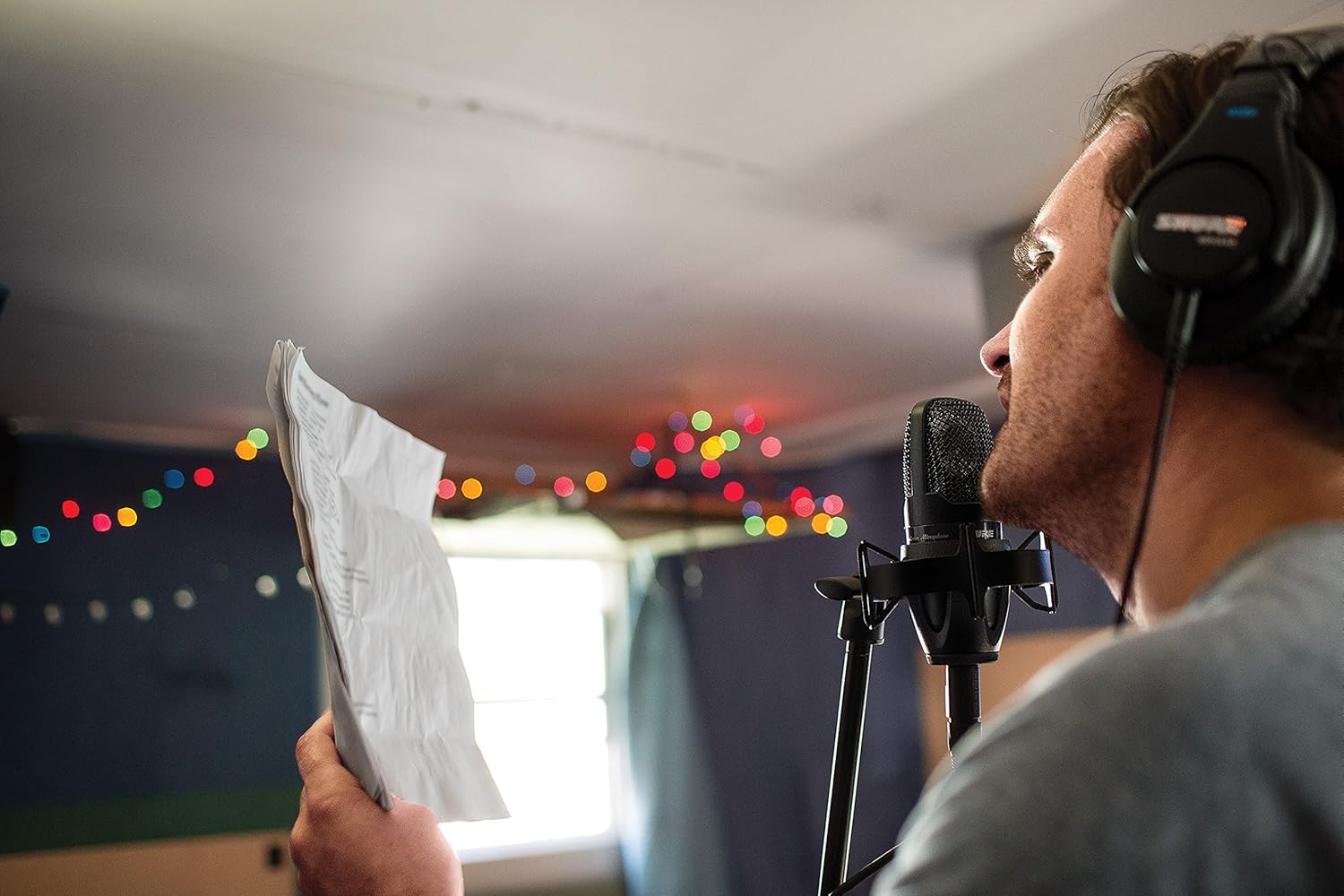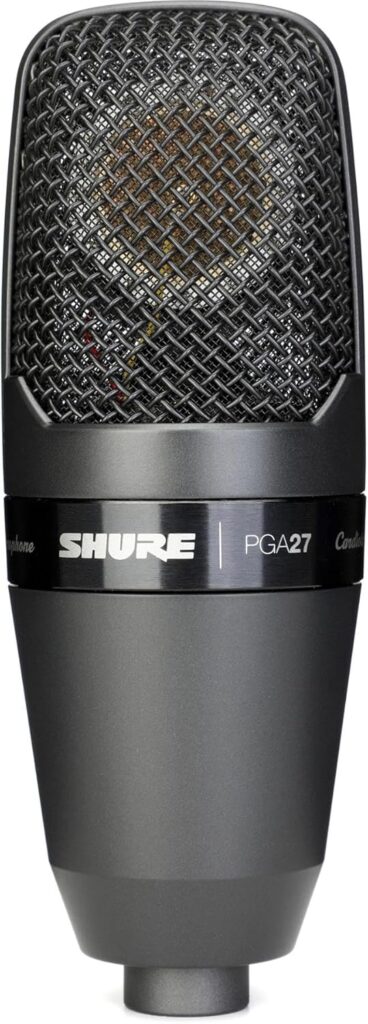Shure PGA27 Review
When it comes to microphones, Shure is a name that resonates with quality, durability, and reliability. Known for iconic models like the SM57 and SM58, Shure has built a reputation that spans decades in both live performance and studio recording. But not every microphone in their lineup is aimed at the high-end professional market. Enter the Shure PGA27, a large-diaphragm condenser microphone from their PG Alta series, designed to deliver solid performance at an affordable price point. In this review, we’ll dive deep into what the PGA27 offers, how it performs across different applications, and whether it’s worth your investment in 2025.
Shure PGA27 Review
The Shure PGA27 is a side-address, large-diaphragm condenser microphone tailored for capturing vocals, acoustic instruments, and amplified sources with clarity and precision. It’s part of the PG Alta line, which sits at the more budget-friendly end of Shure’s microphone offerings, below the SM and Beta series. Priced typically around $150-$200 (depending on the retailer and included accessories), the PGA27 aims to bring Shure’s renowned build quality and sound to home studio enthusiasts, podcasters, and musicians on a budget.
The microphone features a cardioid polar pattern, a wide frequency response of 20 Hz to 20 kHz, and a high SPL (sound pressure level) handling capability of up to 145 dB (or 130 dB without the pad engaged). It comes equipped with a high-pass filter switch and a -15 dB pad, making it adaptable to a variety of recording scenarios. The package typically includes a shock mount and a padded zipper pouch, though some versions (like the PGA27-LC) exclude the XLR cable.
Design and Build Quality
Straight out of the box, the PGA27 exudes Shure’s signature durability. It sports a sleek, unobtrusive design with a black metallic finish and a matching grille, giving it a professional yet understated look that blends seamlessly into any studio or stage setup. Weighing just over a pound (approximately 453 grams), it feels substantial without being cumbersome—a testament to Shure’s focus on rugged construction.
The side-address design is intuitive for users familiar with condenser microphones, and the included shock mount is a standout feature. The mount is cleverly engineered with a quick-release mechanism that securely cradles the microphone while minimizing low-frequency rumble and handling noise. While not as sophisticated as the “ShureLock” elastic shock mounts found on higher-end models, it does an admirable job for the price. The padded zipper pouch adds an extra layer of protection for transport, making the PGA27 a practical choice for gigging musicians or creators on the move.
One minor critique of the design is the placement of the switches for the high-pass filter and -15 dB pad. Located on the back of the microphone, they’re easy enough to access but might feel slightly less convenient during quick adjustments in a live setting. That said, this is a minor nitpick for a microphone primarily geared toward recording rather than live performance.
Sound Quality
The heart of any microphone review lies in its sound quality, and the PGA27 delivers a performance that’s impressive for its price range—though not without some quirks.
Frequency Response and Character
Shure markets the PGA27 as having a “tailored frequency response for superior reproduction,” but the reality is a bit more nuanced. The microphone exhibits a noticeable boost in the presence and air ranges, peaking around 6-8 kHz (+7 dB) and 12 kHz (+8 dB). This gives it a bright, airy character that can enhance clarity and detail, particularly for vocals and acoustic instruments. However, the low end feels somewhat restrained unless you leverage the proximity effect by positioning the mic closer to the source.
For vocals, this brightness can be a double-edged sword. On one hand, it adds a crisp, articulate quality that cuts through a mix without much EQ tweaking—perfect for spoken word, podcasts, or singers with darker timbres. On the other hand, it can sound a bit harsh or sibilant with brighter voices, requiring some post-processing to tame the highs. Compared to a flat-response microphone like the Rode NT1, the PGA27 has a more pronounced personality, which may appeal to users who prefer a colored sound over a neutral one.
Low-End Performance
The bass response is adequate but not exceptional. At a distance of 6-12 inches, the PGA27 captures a clean midrange and upper frequencies, but the low end lacks the depth and warmth you’d get from higher-end condensers like the AKG C214 or Shure’s own SM27. Engaging the high-pass filter (which cuts below 120 Hz) further thins out the lows, making it useful for reducing rumble but less ideal for sources requiring a full-bodied sound, like a kick drum or male vocals with a rich lower register. That said, moving closer to the source (within 2-4 inches) boosts the proximity effect, adding some welcome low-end heft.
High SPL Handling
Where the PGA27 shines is its ability to handle loud sources. With a max SPL of 130 dB (or 145 dB with the pad), it’s well-suited for capturing dynamic performances—think screaming vocalists, cranked guitar amps, or brass sections. The -15 dB pad is a thoughtful inclusion, ensuring the mic doesn’t distort even under intense sound pressure. This makes it a strong contender for recording scenarios where versatility is key.
Self-Noise
At 22 dBA, the self-noise is on the higher side for a condenser microphone. While this isn’t a dealbreaker for loud sources, it can be noticeable when recording quiet instruments like fingerpicked guitar or soft-spoken dialogue in an untreated room. For comparison, the Audio-Technica AT2020 (20 dBA) and Rode NT1 (4.5 dBA) offer quieter operation, but the PGA27’s noise floor is still manageable with proper gain staging and a decent preamp.
Applications
The PGA27’s versatility is one of its strongest selling points. Here’s how it performs across common use cases:
Vocals
For vocal recording, the PGA27 offers a bright, detailed sound that works well for pop, rock, and spoken word. It’s not as warm or smooth as a Neumann U87 or even a mid-tier condenser like the AKG C214, but it holds its own in a home studio setting. Pair it with a pop filter to control plosives, and you’ve got a solid vocal mic for the price. Singers with sibilant voices might need EQ to roll off the 6-12 kHz range, but that’s par for the course with brighter mics.
Acoustic Instruments
When recording acoustic guitar, the PGA27 captures the shimmer of the strings nicely, though the subdued low end means you might need a second mic (like a small-diaphragm condenser) to fully flesh out the body. For saxophone—a use case often debated online—it performs admirably, delivering a focused sound with enough clarity to highlight the instrument’s tonal nuances. The cardioid pattern helps isolate the sax from room noise, though a dynamic mic like the SM57 might offer a punchier alternative for some styles.
Amplified Sources
The PGA27 truly flexes its muscles with louder sources. Positioned in front of a bass amp or a trumpet, it handles the SPL with ease, retaining detail without clipping. The -15 dB pad is a lifesaver here, ensuring clean recordings even at high volumes. Compared to a dynamic mic like the SM57, the PGA27 offers a wider dynamic range and more air, making it a compelling choice for studio use.
Podcasting and Streaming
For podcasters and streamers, the PGA27 is a viable option. Its clarity in the presence range ensures intelligible speech, and the cardioid pattern minimizes background noise. However, its self-noise and sensitivity to room reflections mean you’ll get better results in a treated space or with a good audio interface.
Comparisons to Competitors
To put the PGA27 in context, let’s compare it to two popular alternatives in its price range:
- Audio-Technica AT2020 ($99-$129): The AT2020 is a staple for budget-conscious creators, offering a flatter response and lower self-noise (20 dBA). It’s less bright than the PGA27 and better suited for neutral recordings, but it lacks the pad and filter switches, limiting its versatility with loud sources.
- Rode NT1 ($269): Priced higher, the NT1 outclasses the PGA27 with its ultra-low self-noise (4.5 dBA) and fuller low-end response. It’s a more polished studio tool, but the PGA27 holds its own for dynamic sources and costs significantly less.
The PGA27 strikes a balance between these two, offering more features than the AT2020 and a competitive price against the NT1, albeit with trade-offs in noise and tonal warmth.
Pros and Cons
Pros:
- Affordable price for a large-diaphragm condenser
- Bright, detailed sound with strong presence
- High SPL handling with -15 dB pad
- Rugged Shure build quality
- Versatile for vocals, instruments, and amps
- Included shock mount and pouch
Cons:
- High self-noise (22 dBA) for quiet sources
- Thin low-end response at a distance
- Brightness can be harsh without EQ
- Switches less accessible in live settings
Final Thoughts
The Shure PGA27 is a solid entry-level condenser microphone that punches above its weight in versatility and build quality. It’s not the quietest or warmest mic on the market, but its bright character, high SPL tolerance, and thoughtful features make it a reliable workhorse for home studios, live recordings, and budget-conscious creators. If you’re looking for a microphone that can handle a wide range of tasks—from vocals to brass to bass amps—without breaking the bank, the PGA27 is a worthy contender.
For those prioritizing neutrality or ultra-low noise (e.g., for classical recording), options like the Rode NT1 or Audio-Technica AT2035 might be better fits. But for musicians, podcasters, and streamers who value durability and flexibility, the PGA27 delivers Shure’s trusted performance at a fraction of the cost of their premium models.


